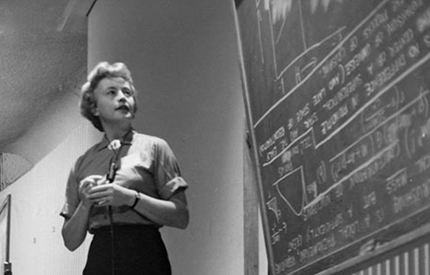American Astronomical Society Announces First Class of AAS Fellows
February 27, 2020 | By Cynthia Dillon
The American Astronomical Society (AAS), the major organization of professional astronomers in North America, has established a new accolade: Fellow of the AAS. Among its first class of fellows is UC San Diego Emerita Professor Margaret Burbidge, singled out as Inaugural Fellow. She was the first women to serve as AAS president from 1976 to 1978, and the first director of UC San Diego’s Center for Astrophysics and Space Sciences.
 AAS Inaugural Fellow E. Margaret Burbidge, who celebrated her 100th birthday in August 2019, had a long and stellar career in multiple fields of astrophysics. One of her most significant achievements was helping to formulate our understanding of nucleosynthesis in stars. The former president of AAS was also the first woman to fill the role. This photo shows Burbidge in Dallas, Texas, in February 1964. Credit: Sky & Telescope.
AAS Inaugural Fellow E. Margaret Burbidge, who celebrated her 100th birthday in August 2019, had a long and stellar career in multiple fields of astrophysics. One of her most significant achievements was helping to formulate our understanding of nucleosynthesis in stars. The former president of AAS was also the first woman to fill the role. This photo shows Burbidge in Dallas, Texas, in February 1964. Credit: Sky & Telescope.
With the “Fellow” distinction, the society will honor members for extraordinary achievement and service, for original research and publication, innovative contributions to astronomical techniques or instrumentation, significant contributions to education and public outreach, and noteworthy service to astronomy and to AAS itself.
An initial group of more than 200 Legacy Fellows has been designated by the AAS Board of Trustees. These include past recipients of certain awards from the AAS or its topical divisions, distinguished AAS elected leaders and volunteer committee members, and previously unrecognized individuals with long histories of outstanding research, teaching, mentoring and service—such as Burbidge.
“The Board is simply thrilled to honor Margaret in this way,” says current AAS President Megan Donahue, Michigan State University. “At 100 years old, she has seen almost the full history of the society. She has been an inspiration for so many, especially women like me who use large telescopes, something not possible before Margaret famously broke the observatory gender boundary in the mid-20th century.”
Many other scientific societies acknowledge their members’ scientific accomplishments and service to the field by electing them as fellows, something the AAS hasn’t done before.
“Our members were missing out on the opportunity to not only celebrate the accomplishments of individual astronomers,” says Donahue, “but also the success of the field more generally.”
Beginning this year, there will be an annual call for nominations of new AAS Fellows. Since the intent is to reward career achievement and service, nominees are expected to have been full members of the AAS for at least five consecutive years or 10 non-consecutive years. Under special circumstances, long-term international, educator, alumni or amateur affiliate members who meet similar requirements may also be eligible. The society will establish an AAS Fellows Selection Committee that will evaluate nominations and forward those they approve to the Board of Trustees for ratification.
“I know that future AAS presidents will take great pleasure in announcing the new class of fellows during the prize ceremony that is a highlight of every winter AAS meeting,” Donahue said.
